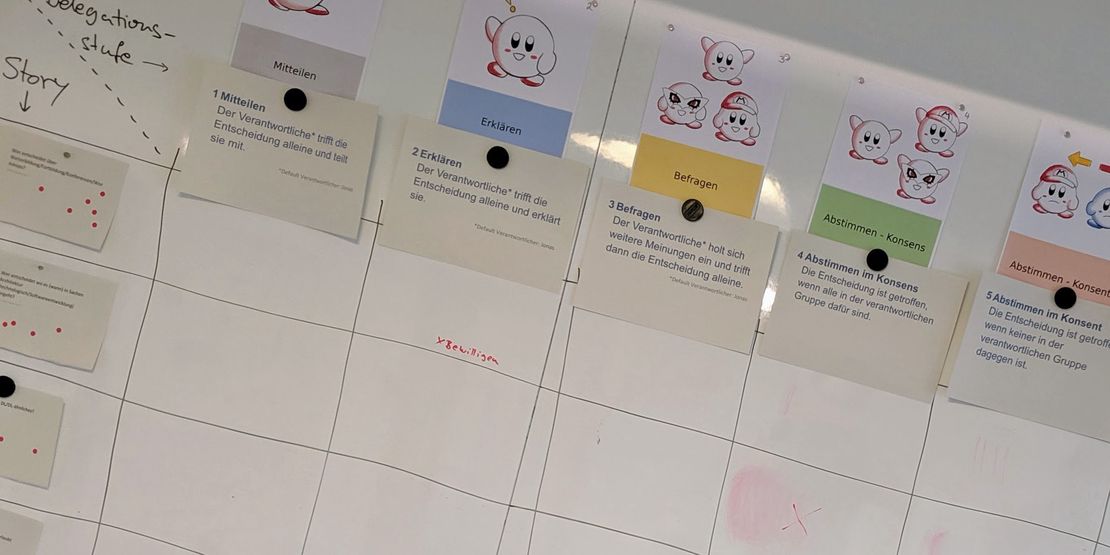
Decision-Matrix: Improve team self-organisation
Often, teams struggle because no one knows who should make decisions. This confusion can lead to long, unproductive meetings, delayed actions, and general frustration. Having clear guidelines on who makes decisions can help teams work better and faster. One way to achieve this is by using a decision matrix, which outlines who decides and how they do it. We’ll explore an eight-level decision matrix that shows the different ways decisions can be made and who is involved at each level.
The Decision Matrix
| Who decides | ... how | Decision Level |
|---|---|---|
| The owner | ... decides. | Level 1 |
| ... decides and explains. | Level 2 | |
| ... seeks advice and decides. | Level 3 | |
| A group | ... decides if everyone supports it. | Level 4 |
| ... decides if no one is against it. | Level 5 | |
Each individual | … seeks advice and decides. | Level 6 |
| … decides and explains. | Level 7 | |
| … decides silently. | Level 8 |
The Decision Matrix Explained
The decision matrix categorizes decisions based on who makes them and the extent of consultation or explanation involved. Here’s a breakdown of the eight levels:
Levels 1-3: Owner-Centric Decisions
Level 1: The Owner Decides
At the most autonomous level, the owner or leader makes decisions unilaterally. This approach can be effective for urgent decisions or when the owner has the most expertise.
Level 2: The Owner Decides and Explains
Here, the owner still makes the decision but provides an explanation to the team. This fosters transparency and helps the team understand the rationale, potentially increasing buy-in.
Level 3: The Owner Seeks Advice and Decides
In this scenario, the owner consults with team members before making a decision. This approach leverages collective input while retaining final decision-making authority.
Levels 4-5: Group-Centric Decisions
Level 4: The Group Decides if Everyone Supports It
Decisions are made collectively, requiring unanimous support. This ensures total agreement but can be time-consuming and challenging to achieve consensus.
Level 5: The Group Decides if No One is Against It
A slightly more flexible approach, decisions are made as long as there are no objections. This method balances inclusivity and efficiency, allowing for quicker consensus while addressing major concerns.
Levels 6-8: Individual-Centric Decisions
Level 6: Each Individual Seeks Advice and Decides
Individuals make their own decisions but seek advice beforehand. This encourages collaboration and informed decision-making while maintaining personal autonomy.
Level 7: Each Individual Decides and Explains
Here, individuals make decisions independently but must explain their choices to the team. This promotes accountability and transparency within the organization.
Level 8: Each Individual Decides Silently
The most autonomous level for individuals, decisions are made without consulting others or providing explanations. This can be efficient for minor or routine decisions but may lack transparency and cohesion.
Practical Applications of the Decision Matrix
Implementing this decision matrix can significantly enhance clarity within an organization. By clearly defining who is responsible for what decisions and how they should approach them, teams can avoid confusion and streamline processes.
Different situations may call for different levels of decision-making. For example, in crisis situations, Level 1 (The Owner Decides) might be most appropriate. Conversely, for strategic planning, involving the group (Levels 4 or 5) could yield better results.
Encouraging various levels of consultation and explanation fosters a culture of engagement and accountability. When team members feel their input is valued, they are more likely to be committed and motivated.
The matrix also helps balance the need for individual autonomy with the benefits of collaborative input. Levels 6 and 7, for instance, empower individuals while ensuring they remain connected to the team’s objectives and insights.